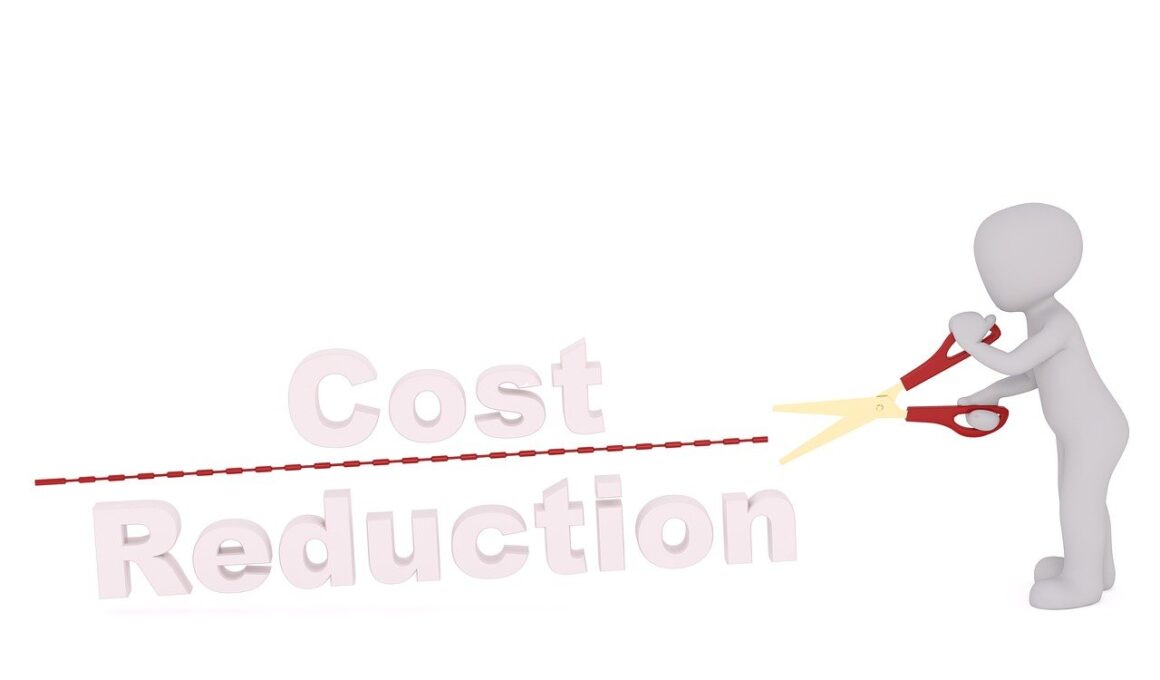Reducing Overhead Expenses Without Sacrificing Quality
In today’s competitive business environment, managing operational costs effectively is more critical than ever. Overhead expenses can significantly influence a company’s profitability. Therefore, implementing strategic cost reduction techniques without sacrificing quality is essential. Identifying areas where unnecessary spending occurs can provide insights into potential savings. Companies can analyze their overhead by reviewing expenses related to utilities, staff salaries, and maintenance costs. Streamlining these processes can lead to substantial savings. Another approach is outsourcing non-core functions to specialized firms to benefit from their expertise. This allows a company to focus on its strengths while reducing costs associated with hiring, training, and managing a workforce. Investing in technology can enhance efficiency, leading to reduced overhead in the long term. Adopting energy-efficient systems can lower utility costs significantly without compromising quality. Employee training and engagement are crucial, as a motivated team can drive innovation and efficiency in operations. Open communication regarding cost-saving measures helps create a culture focused on quality and profitability. Regular assessments will ensure that the implemented strategies align with the company’s quality standards while achieving overhead reductions.
Identifying Unnecessary Costs
The first step in reducing overhead costs is to identify and eliminate unnecessary expenses effectively. A thorough analysis of all expenses provides insight into which areas consume the most resources. Companies should categorize overhead into fixed and variable costs, allowing for targeted reductions. For instance, scrutinizing subscriptions to software or services that are underutilized can yield immediate savings. Evaluating contracts and agreements with suppliers may also highlight opportunities for negotiation or better deals. Additionally, ensuring that operational processes are as lean as possible contributes to overall cost reduction. Implementing just-in-time inventory management can minimize waste and storage costs. Energy costs often represent a significant portion of overhead, making energy audits essential. By discovering inefficiencies in energy usage, businesses can implement corrective measures to lower bills. Regular maintenance schedules for equipment can prevent costly repairs and extend the life of assets, leading to additional savings. Transparency in finding these unnecessary costs fosters an organization-wide commitment to cost efficiency. Engaging employees in identifying solutions ensures they take ownership of the company’s financial health while promoting a culture of continuous improvement.
Leveraging Technology for Cost Efficiency
Technology has transformed how businesses operate, offering various solutions to cut overhead expenses while improving quality. Investing in automation can eliminate repetitive tasks, allowing employees to concentrate on higher-value activities. Tools such as Enterprise Resource Planning (ERP) software provide comprehensive visibility into organizational processes, enabling data-driven decision-making. Moreover, cloud-based systems can reduce costs associated with maintaining physical infrastructure, offering flexibility and scalability. Companies can also implement Customer Relationship Management (CRM) systems to enhance communication with clients and assess their needs accurately. This personalized approach can reduce marketing waste and improve client retention rates, directly impacting overhead. Additionally, utilizing analytical tools can provide insights into customer behavior and operational inefficiencies, guiding targeted improvements. Training programs enhanced by technology ensure employees possess the necessary skills to leverage these tools effectively. By creating an informed workforce, quality in service delivery is guaranteed while expenses are managed judiciously. Cybersecurity investments also protect sensitive data, preventing financial losses associated with breaches. Ultimately, technology is a crucial ally in executing cost reduction strategies without undermining quality objectives.
Implementing Employee Training and Engagement
Involving employees in cost reduction strategies fosters a culture of engagement and productivity. Workers directly involved in operational tasks possess firsthand knowledge of inefficiencies and bottlenecks. Thus, organizations should encourage a participatory approach where employees suggest cost-cutting measures. Providing them with adequate training on efficient processes can result in significant overhead reductions. When employees feel that their input is valued, they become more invested in the company’s success. Developing training programs that focus on enhancing skills helps improve overall operational quality. Offering continual professional development opportunities ensures that employees keep pace with industry standards and practices. Furthermore, recognizing and rewarding employees for their contributions to overhead reduction initiatives reinforces a positive culture surrounding cost efficiency. Team-building activities can also foster collaboration among different departments, leading to innovative ideas for cost management. Open communication about financial goals encourages a collective effort from the workforce. By maintaining transparency about how saved costs can be redirected to improve quality or invest in growth, employers can build stronger commitment levels among employees. Such investments in personnel yield returns through improved productivity and lower overall overhead expenses.
Reviewing Supplier Contracts for Cost Savings
Establishing strong relationships with suppliers can lead to better pricing and terms for services and products essential to operations. Regularly reviewing supplier contracts is crucial, as market conditions change and new offerings become available. Companies often remain locked into long-term agreements that may no longer be financially viable. Conducting periodic evaluations on supplier performance and pricing helps organizations identify savings opportunities. Moreover, establishing competitive bidding processes ensures that companies always receive the best value for their purchases. Diversifying supplier bases can also enhance negotiation power. When suppliers know they are competing for your business, they are more likely to provide favorable terms. Organizations can benefit from bulk purchasing agreements, which can lead to reduced costs and savings passed on to customers. Leveraging technology allows companies to monitor supplier performance and delivery times accurately. Enhancing these relationships by collaborating on cost-saving measures can yield shared benefits. Negotiating payment terms that align with cash flow needs helps manage overhead expenses effectively. Furthermore, sourcing materials locally can decrease shipping costs and delays, directly impacting operational efficiency without sacrificing quality.
Adopting Lean Management Principles
Implementing lean management principles is effective for refining processes and reducing overhead costs with a focus on quality. Lean methodologies emphasize eliminating waste and optimizing resources for maximum efficiency. By methodically analyzing each process step, businesses can identify where time and materials are wasted. Process mapping helps visualize workflows and highlight inefficiencies that hinder productivity. Equally important is cultivating a mindset dedicated to continuous improvement, inspiring employees to seek enhancements consistently. Organizing regular team meetings to discuss inventory levels, production schedules, and potential bottlenecks fosters collaborative problem-solving. Training staff on lean principles empowers them to identify opportunities for waste reduction. The 5S framework, focusing on Sort, Set in order, Shine, Standardize, and Sustain, can improve workplace organization and efficiency. This ensures that all team members are aligned with the organization’s goals while engaged in maintaining quality standards. Conducting root cause analyses can identify the sources of recurring issues, allowing organizations to address them effectively. Lean practices not only lower overhead but also enhance product and service quality, ultimately improving customer satisfaction.
Continuous Monitoring and Feedback
Establishing a routine for continuous monitoring and gathering feedback is crucial for maintaining quality while reducing overhead expenses. Implementing key performance indicators (KPIs) enables companies to track their progress towards cost reduction goals effectively. Regular assessments can reveal trends that may require intervention before they escalate into more significant problems. Soliciting feedback from employees and clients provides valuable insights into perceived quality and operational effectiveness. Gaining firsthand perspectives can highlight areas that need improvement. Companies should adopt a proactive approach by involving employees in regular check-ins about cost-saving measures implemented. Creating platforms for open dialogue encourages everyone to share ideas and solutions. Feedback loops that incorporate client experiences ensure that quality is not compromised as costs are cut. Tracking customer satisfaction metrics aids organizations in understanding how cost reductions impact their offerings. Transparency regarding changes made in operation fosters trust and reassures stakeholders about ongoing quality commitments. By continuously monitoring and adjusting operations based on feedback, companies can achieve sustainable cost reductions without sacrificing the quality that clients expect.
Conclusion and Moving Forward
In conclusion, reducing overhead expenses without sacrificing quality requires a multifaceted approach involving employee engagement, technology adoption, and systematic reviews of processes and supplier contracts. Organizations must understand their operational landscape to identify unnecessary costs accurately. Investing in training and fostering a collaborative workplace culture can yield significant efficiency gains while maintaining service and product quality. The utilization of technology serves as an enabler, providing the tools necessary to streamline operations and analyze performance effectively. Moreover, the adoption of lean management principles guides entities toward eliminating waste and enhancing overall productivity. Continuous monitoring, feedback loops, and transparency are vital elements in ensuring that all cost-saving measures align with business objectives. As companies move forward, establishing strategic partnerships with suppliers can also contribute to sustained savings. Together, these strategies pave the way for a robust framework capable of achieving significant overhead reductions over time. As businesses master the art of balancing cost management with quality maintenance, they position themselves competitively for future growth and profitability. The journey demands commitment, but the return on investment in satisfactory operations will likely translate into brand loyalty and increased market share.


